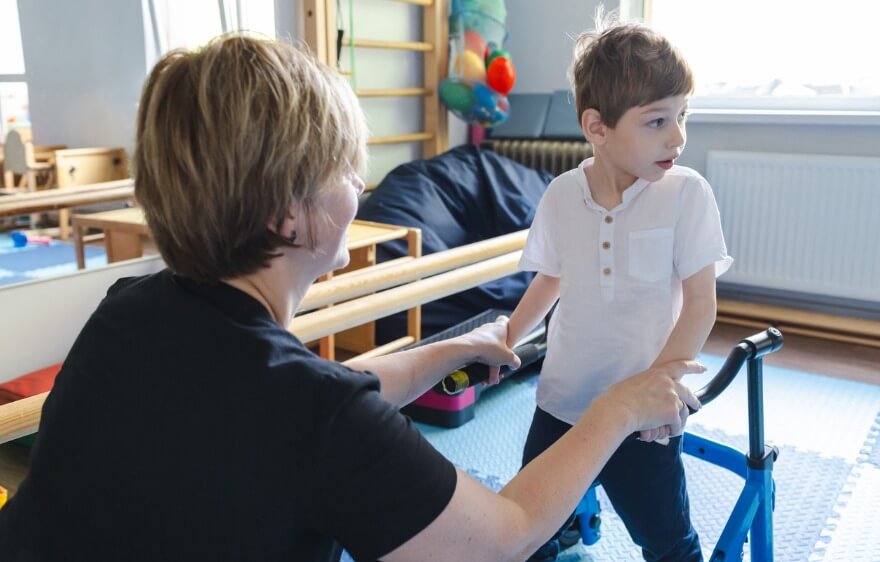We love a good book at The Hello Clinic. We regularly clean out our local library shelves 🙂 But we love books even more when they lend themselves to interactive play. Pairing a favorite read-aloud with themed play allows our kiddos to learn new skills in a structured format (the book) and then apply those skills in a more informal play situation. What’s more, modeling literacy+play gives parents an opportunity to see how they can use books at home to target their child’s goals.
We have put together a list of some of our most loved books coupled with engaging play activities that allow clinicians and parents to take reading from a Level One to a Level FUN.
Playing with Board Books
First up – board books! For the littles in your life, these are always a hit. They can take a lot of abuse and keep on ticking! And because board books hold up so well, they are also pretty conveniently found at second-hand stores and library sales. Eric Carle and Peggy Rathman produce some our go-to board books and we also love those little flap books like Where’s Spot. We can’t recommend them enough! Read on for 3 of our favorites and how we like to play with them . . .
1. Good Night Gorilla by Peggy Rathman
This classic, wordless picture book is currently being held together with tape because it gets used so much in our therapy rooms 🙂 Here’s what you’ll definitely need for the play sequence with Good Night Gorilla:
- Cages: We create “cages” from a variety of materials but the easiest is a batch of dixie cups with a flap cut out for the “door.” If you have the Critter Clinic on hand, it can also be a great substitute for zoo cages.
- Toy animals: Finding a monkey, elephant, lion and giraffe isn’t too hard in our bins of toys. The hyena and the armadillo…a little tougher! So we use a dog and a turtle in their stead.
- Boy/girl dolls: For the zookeeper and his wife.
- A key: Really anything will work — a real key, a toy, or even a penny — bonus points for the latter as more representational play :).
- Extras if you have them: a toy bed, a dollhouse, a mouse and/or a banana extend the play event more.
How we play: We set up the scene by putting all of the animals in their cages and the acting out the story as we tell the story. Afterward, we may act out the story again to work on retells and/or articulation. We also may add in more animals or change the story in some way to work on flexibility (e.g. the elephant lets everyone out, the zookeeper discovers the animals, the monkey won’t leave the house). To integrate movement, we set the cages up around the room and the kiddo can be the “gorilla,” letting all the animals out of their cages. This type of play would also be great for Dear Zoo by Rod Campbell!
2. The Very Busy Spider by Eric Carle
Who doesn’t love Eric Carle books? We only wish we were that creative! This is a good one for littles with an expressive language delay who might be working on animal/environmental sounds. Other good target goals for this book are s-blends, especially /sp/, and sequencing skills. The Very Busy Spider keeps us busy with a sticky web and a trail of animals who all get stuck. For this book+play activity you will need:
- Thick masking tape (painters tape also works great)
- Toy spider
- Basic farm animals and then as many other animals as you want!
How we play: Generally we start by reading the book aloud to directly target any specific goals. After the read aloud, we build a giant spider web out of tape, using chairs, tables, the wall, door handles, etc. to make it a 3D version. We put the spider in the middle, and then act out the animals all coming to ask it to play and then getting “stuck” on the web. Depending on how big the web is, your child could also get stuck! After all the animals are on on the web, the spider can “eat” all the animals or “free” them, giving you more opportunities to practice your target goals
3. Little Cloud by Eric Carle
Yep, another one by the great EC. This is a very fun, super hands-on play experience that works wells for a group or in a 1:1 situation. This delightful little book targets vocabulary goals like same/different, opposites, and synonyms. It also provides lots of opportunities to expand language with descriptive terms. Here’s your prep list:
- Large piece of blue paper
- Cotton balls
- Straws
- White tempera paint
- Sponges
- Scissors
- Glue
How we play: We begin by reading the story aloud and talking about all the shapes Little Cloud makes in the story. What do they look like, what connections the kid(s) have with the animals/objects featured, and how Little Cloud moved in the story (e.g. slow, fast, loud, quiet). After the read aloud, we pull out the blue paper (“sky”) and set cotton balls (“clouds”) on top. Each kiddo gets a straw. With your cues, they position the straw in front of a “cloud” and use their breath to make it move across the “sky.” It can move quickly or slowly, in a straight line or crooked, loudly or quietly…you get the idea. After doing this for a few minutes pour some white tempera paint on the paper and ask the kids to make it move/grow like a cloud by blowing through the straw. Talk about if it’s harder or easier than the cotton ball. And finally, bring out the sponges and cut them into cloud shapes. Dip them into the paint and make a “cloudy sky” on the blue paper.
Another fun collaborative activity for a group of kids is to put on some peaceful music and have the kids dance around pretending to be a “Little Cloud.” When you turn off the music, the kids start to move towards each until they form a tight huddle. As soon as they are all together, clap your hands loudly (or better yet, use cymbals) to create “thunder.” At this cue, all the kids make their hands mimic rain as they come to their knees and start beating on the floor to make a “rain sound.”
We could go on and on with board books, of course. Happy reading and happy playing!






